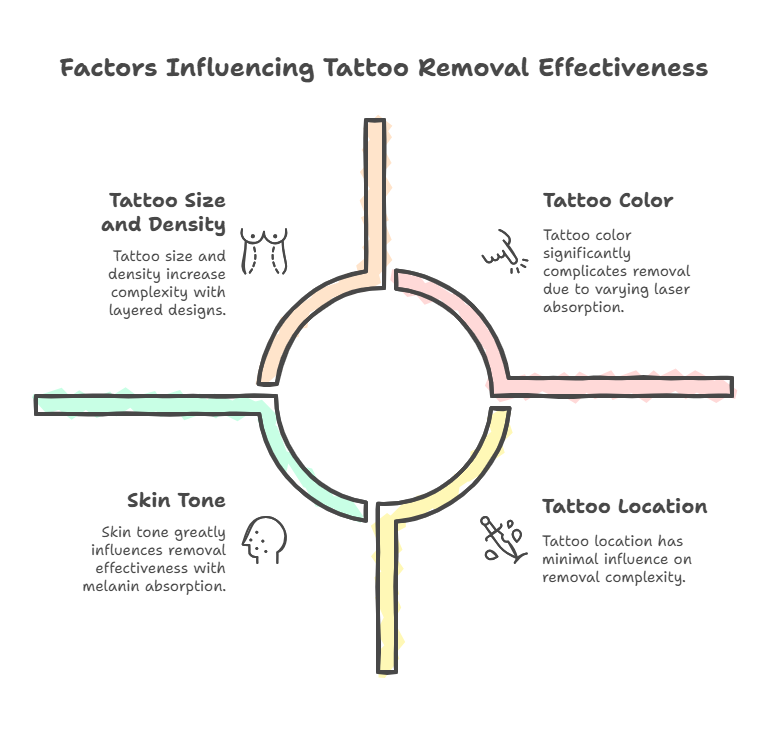Thinking about getting rid of that old ink tattoo? You’re not alone. Tattoo removal has become increasingly popular as people’s tastes change or they simply want a fresh start. Before you proceed, it’s important to understand the removal process. Let’s break down everything you need to know about removing tattoos.
What Is Tattoo Removal?
Tattoo removal is the method used to eliminate an unwanted tattoo from your skin. It’s more involved than simply erasing a mark because body art is intended to be permanent. Achieving clear skin again requires time, patience, and the correct removal procedure.
“Tattoo removal is a gradual process. Factors like ink color, tattoo age, and skin type play a big role in how effectively it fades. A personalized treatment plan is key to achieving the best results.”
Dr. Will Kirby
Several tattoo removal treatments exist, but laser tattoo removal is the most widely used and often considered the most effective. This laser treatment functions by fragmenting the tattoo pigment within your skin. Your body’s natural systems then work to flush out these broken-down ink particles1.
Choosing the right clinic, often within the field of cosmetic dermatology, is vital for safe and effective removal work. It’s essential to have realistic expectations about the outcome. Complete removal might not always be possible for every ink tattoo.
How Does Laser Tattoo Removal Work?
Laser tattoo removal work utilizes focused beams of high-intensity laser light to target and disintegrate the ink embedded in your skin. The mechanism involves precise application of light energy. Here’s a simple overview of this tattoo removal procedure:
- The laser device emits rapid pulses of specific light wavelengths.
- This specialized light is selectively absorbed by the tattoo ink particles.
- Absorption of this energy causes the ink particles to heat intensely and shatter into much smaller particles.
- Your body’s immune system identifies these fragments as foreign material and gradually clears them away over weeks.
This isn’t a single-visit solution; patience is required. Most unwanted tattoos requires multiple removal sessions to achieve the desired level of fading or complete tattoo removal. The exact number of tattoo removal sessions needed varies based on the tattoo’s characteristics and individual factors.
Different lasers are used for different tattoo color profiles, as certain pigments absorb specific wavelengths more effectively. Advances in laser technology continue to improve the effectiveness and safety of the removal procedure. This makes the laser tattoo removal work more efficient than older methods2.
Is Tattoo Removal Painful?
It’s important to be honest about the sensation during laser tattoo removal. Many compare the feeling to a rubber band repeatedly snapping against the skin. However, most individuals report that the discomfort is less intense than getting the original tattoo.
To manage pain, clinics typically offer topical numbing creams or local anesthetic injections. You might experience some soreness or discomfort in the treated area following the laser treatment. This is generally manageable with standard aftercare practices.
The level of discomfort can also depend on the tattoo’s location and your personal pain threshold. Technicians work to make the user experience as comfortable as possible. Using an ice pack immediately after can help soothe the skin.
How Long Does Tattoo Removal Take?
Patience is essential throughout the tattoo removal journey, as it is not a quick fix. On average, achieving complete removal or significant fading takes approximately 6 to 12 removal sessions. These appointments are usually scheduled 6 to 8 weeks apart, allowing the skin time to heal and the body to clear the fragmented ink.
The full removal process can span from 6 months up to 2 years, or sometimes longer. Remember that your skin needed time to heal after the initial tattooing process. Removing that ink requires a similar commitment to healing between tattoo removal treatments.
Factors like the efficiency of your immune system and adherence to aftercare instructions also influence the overall duration. Consistency with appointments is key to progressing through the removal procedures effectively. Failing to allow sufficient skin heal time can increase risks3.
Factors That Affect Tattoo Removal
Not all tattoos respond uniformly to removal treatments. Several factors influence the ease and speed of the tattoo removal work:

Tattoo Color
Interestingly, certain colors present more challenges than others during the removal procedure. Black tattoos and dark blue inks generally respond best to laser treatment as they absorb laser wavelengths effectively. Brighter colors such as green, yellow, orange, and light blue can be more resistant and may require more specialized lasers or additional tattoo removal sessions.
The specific tattoo pigment used by the tattoo artist also plays a role. Some pigments are more stable and harder to break down than others. Newer inks might also pose different challenges compared to older, faded tattoos.
Tattoo Size and Density
Logically, larger and denser tattoos demand more time and effort to remove tattoo ink compared to smaller tattoos. Tattoos featuring heavy lines, significant shading, or large blocks of solid color will typically require more removal sessions. The amount of ink packed into the skin directly impacts the length of the removal process.
Smaller tattoos require fewer pulses per session and generally less overall treatment time. Layered tattoos, where one design covers another, are particularly complex. They involve multiple layers of ink at different depths.
Tattoo Location
The location of the unwanted tattoo on your body can affect fading speed. Tattoos situated closer to the heart, like on the chest or upper back, often fade faster due to better blood circulation in those areas. Consequently, tattoos on extremities like ankles or fingers might take longer to completely remove.
Areas with thinner skin might also heal differently or be more sensitive during treatment. The technician will consider the location when planning the removal procedures. Proper circulation is vital for carrying away the smaller particles of ink.
Your Skin Tone
Laser tattoo removal generally shows the most straightforward results on individuals with fairer skin types and dark tattoos. For those with darker skin tones, the removal process might take longer and necessitate specific laser wavelengths (like Nd:YAG) and settings. This approach helps minimize the risk of pigmentary changes in the surrounding skin color.
Melanin, the pigment responsible for skin color, can absorb laser energy. Therefore, treatments on darker skin must be performed carefully by experienced practitioners. Adjusting laser parameters is crucial to target the tattoo ink without affecting the natural skin pigment.
Your Health and Lifestyle
Your overall health significantly impacts how effectively your body eliminates the shattered ink particles. A robust immune system facilitates faster clearing of the ink fragments. Habits like smoking can constrict blood vessels and impair circulation, potentially slowing down the removal process and healing4.
Maintaining a healthy diet, staying well-hydrated, and getting adequate rest support your body’s natural healing capabilities. Certain medical conditions or medications might also affect the outcome or healing time. Discussing your health history during the consultation is important.
Preparing for Tattoo Removal
If you have decided to proceed with tattoo removal treatments, taking preparatory steps can contribute to a better outcome. Consider these guidelines before your first removal session:
- Select a reputable clinic specializing in cosmetic dermatology or laser tattoo removal work, staffed by experienced professionals. Check reviews and credentials.
- Avoid significant sun exposure, tanning beds, or spray tans on the treated area for several weeks prior to treatment, as tanned skin increases risks.
- Keep your skin well-hydrated by drinking plenty of water and maintain a balanced diet to support overall health.
- If you smoke, consider quitting or reducing intake, as smoking can impede the healing process and slow ink clearance.
- Inform your technician about any medications you take, especially blood thinners or photosensitizing drugs, before your appointment. You might need to pause certain medications temporarily.
- Ensure the clinic has a clear privacy policy regarding your personal and medical information. Many allow you to book online or request appointment through their website.
What to Expect During a Tattoo Removal Session
Understanding the typical flow of a tattoo removal procedure can help alleviate any anxiety. Here’s what generally happens during a laser tattoo removal appointment:
- The technician will cleanse the skin over the unwanted tattoo thoroughly. A topical numbing cream might be applied about 30-60 minutes beforehand if desired.
- You will be provided with special protective eyewear to shield your eyes from the intense laser light. The technician will also wear protective eyewear.
- The laser handpiece is passed over the tattoo, delivering very short, rapid pulses of light energy onto the tattooed skin.
- You will likely feel a sensation often described as like hot grease splatters or a rubber band snapping against the skin with each pulse.
- The duration of the actual lasering is usually quite short, typically lasting from a few minutes for small tattoos up to 30 minutes for larger pieces.
- Immediately after the laser treatment, the treated area is often cooled with an ice pack or a cooling device, and a soothing ointment and bandage are applied.
Aftercare for Tattoo Removal
Diligent aftercare following each removal session is vital for proper healing, minimizing side effects, and achieving the best possible results from the removal work. Follow these recommendations closely:
- Keep the treated area clean and dry for the first day or as instructed. Gently wash with mild soap and water after the initial period.
- Apply an antibiotic ointment or recommended healing balm and keep the area covered with a sterile dressing for the first few days.
- Resist the urge to pick at any scabs, blisters, or crusts that form, as this can lead to scarring or infection. Allow them to heal naturally.
- Protect the healing skin from direct sun exposure completely. Use a high-SPF sunscreen (SPF 30+) on the area once healed if sun exposure is unavoidable.
- Avoid swimming pools, hot tubs, saunas, and soaking the area in baths until the skin is fully healed to prevent infection.
- Refrain from strenuous exercise that causes excessive sweating in the treated zone for the first 24-48 hours.
- Avoid scrubbing the area vigorously; pat it dry gently after washing.
- Contact the clinic or your primary care physician if you notice signs of infection like increasing redness, swelling, pus, or fever.
Potential Side Effects and Risks
Laser tattoo removal is generally considered safe when performed by a qualified professional, but like any medical procedure, it carries potential side effects and risks. Being aware of these possibilities is important:
- Common temporary effects include redness, swelling, and tenderness in the treated area.
- Blistering or scabbing is a normal part of the healing process for some individuals. Do not pick at them.
- Temporary or permanent changes in skin texture, such as roughness or smoothness, can occur.
- Hyperpigmentation (darkening of the skin) or hypopigmentation (lightening of the skin) may happen, especially with improper laser settings or sun exposure. These changes are often temporary but can sometimes be long-lasting, particularly for those with darker skin.
- While rare with modern lasers and proper technique, scarring is a potential risk, especially if aftercare instructions are not followed or if blistering is severe.
- An allergic reaction to the dispersed ink particles is uncommon but possible.
- Infection can occur if the treated area is not kept clean or if blisters/scabs are picked.
- It’s good practice for the clinic to check for any signs of skin cancer in the area before starting treatment, although the laser itself does not cause it.
Most side effects like redness and mild swelling subside within a few days to a week. Discuss any concerns about skin irritation or potential complications with your cosmetic dermatology provider before starting the removal treatments.
Alternatives to Laser Tattoo Removal
While laser tattoo removal remains the gold standard for removing tattoos, other methods exist, though they may be less common or suitable only for specific situations:
Surgical Excision
Surgical removal involves a surgeon cutting out the section of tattooed skin entirely and then suturing the remaining skin edges together. This surgical removal option guarantees complete removal of the ink but leaves a surgical scar. It is typically only practical for smaller tattoos where enough surrounding skin is available to close the wound5.
Dermabrasion
This mechanical exfoliation technique uses a rapidly rotating abrasive device to sand away the upper and middle layers of skin containing the tattoo ink. Dermabrasion can be painful, has a longer recovery time, and carries a higher risk of scarring and skin texture changes compared to laser removal. It is less commonly performed today for tattoo removal procedures.
Chemical Peels
Certain types of strong chemical peels using acids like Trichloroacetic Acid (TCA) can be applied to the skin to remove its outer layers, potentially fading a tattoo over time. However, chemical peels are generally less effective than lasers, especially for deep or dense ink, often only managing to lighten tattoo pigment rather than completely remove it. This method also requires multiple treatments and carries risks like burns and scarring.
Related cosmetic dermatology procedures, such as laser resurfacing, are designed to improve skin texture and tone, but they are not primary methods for tattoo removal. While some clinics may offer additional treatments like photodynamic therapy or skin tightening to enhance overall skin health, these options do not directly target tattoo ink.
For those interested in complementary treatments that support healthy, clear skin—especially after tattoo removal—exploring a deep cleansing facial can be a great addition to your skincare routine.
Tattoo Cover-Ups
Although not a removal method, getting a cover-up tattoo is a popular alternative for dealing with an unwanted tattoo. A talented tattoo artist can design a new piece of body art to effectively conceal the old one. Sometimes, a few sessions of laser removal are used first to lighten tattoo ink, making the cover-up easier and more successful.
It is important to research these alternatives thoroughly and discuss them with a professional. Emerging techniques are sometimes explored in clinical trials, but laser remains the most proven technology. Remember that methods like hair removal lasers are different and not suitable for tattoo removal work.
The Cost of Tattoo Removal
The tattoo removal cost is a significant factor for many people considering the procedure. It’s important to understand that removal cost is typically not covered by health insurance as it’s considered a cosmetic choice. The price varies considerably based on several elements:
- The size, complexity (multiple colors, dense ink), and age of the tattoo significantly influence the removal cost. Larger, more intricate tattoos cost more to remove.
- The total number of removal sessions needed for desired results is the primary driver of the overall expense. More sessions mean higher total costs.
- The type of laser technology used can affect the price per session. Advanced pico-second lasers might be more expensive but potentially require fewer sessions for certain inks.
- The geographic location of the clinic (real estate costs factor in) and the expertise of the practitioner play a role in pricing. Clinics in major cities often charge more.
- Black tattoos respond well and might require fewer sessions, potentially lowering the total removal cost compared to multicolored tattoos.
On average, a single tattoo removal session might range from $200 to $500, or even more. For a complete tattoo removal, the cumulative cost can easily range from $1,000 to $10,000, and sometimes higher for very large or complex pieces. Many clinics offer package deals or financing options to help manage the expense. Some advertisements based pricing might seem low but check what is included.
Here’s a rough comparison table (costs are estimates and vary widely):
| Factor | Typical Impact on Cost |
|---|---|
| Small, Black Tattoo | Lower end of cost range (fewer sessions) |
| Large, Multi-Colored Tattoo | Higher end of cost range (more sessions, potentially multiple lasers) |
| Professional Tattoo Artist Ink | Often requires more sessions (denser ink) |
| Amateur Tattoo Ink | Can be variable, sometimes easier, sometimes harder |
| Clinic Location (Major City) | Potentially higher per-session cost |
| Laser Type (Pico vs. Q-Switched) | Pico lasers might have higher session cost but potentially fewer sessions needed |
Always have a detailed consultation to get a personalized estimate of the number of sessions and total removal cost before committing. Ensure all clinic policies are clear; many institutions have their rights reserved regarding treatment specifics.
Conclusion
Deciding on tattoo removal is significant, but it offers a viable path if you regret your body art or wish to clear your skin. While the removal process demands time, patience, and financial investment, modern laser tattoo removal techniques can effectively fade or completely remove unwanted ink, helping you get your tattoo removed. Success hinges on managing expectations and understanding that tattoos respond differently to treatment.
Remember to research thoroughly, choose a qualified cosmetic dermatology clinic with experienced professionals, and diligently follow all pre-treatment and aftercare instructions. Discussing your goals and concerns during a consultation will help tailor the removal procedures to your specific needs and skin type. With the correct approach and commitment, you can effectively remove tattoo ink and embrace clear skin once more.
Small Step, Big Impact
Before embarking on your tattoo removal journey, consult with a certified dermatologist or tattoo removal specialist to discuss the best method for your specific tattoo and skin type. Remember, understanding the process and setting realistic expectations are key to achieving the desired outcome.
Listen to this article
This is an AI generated Podcast version of the article.
- https://pmc.ncbi.nlm.nih.gov/articles/PMC2884836/[↩]
- https://www.researchgate.net/publication/44674419_Lasers_for_tattoo_removal_A_review[↩]
- https://iris.who.int/bitstream/handle/10665/44102/9789241597906_eng.pdf[↩]
- https://www.vanishclinic.com/post/the-importance-of-being-healthy-for-tattoo-removal-intoronto-why-80-of-the-work-is-done-by-your-body[↩]
- https://www.asds.net/skin-experts/skin-treatments/surgical-excision-for-unwanted-tattoos[↩]



